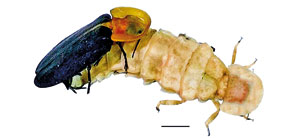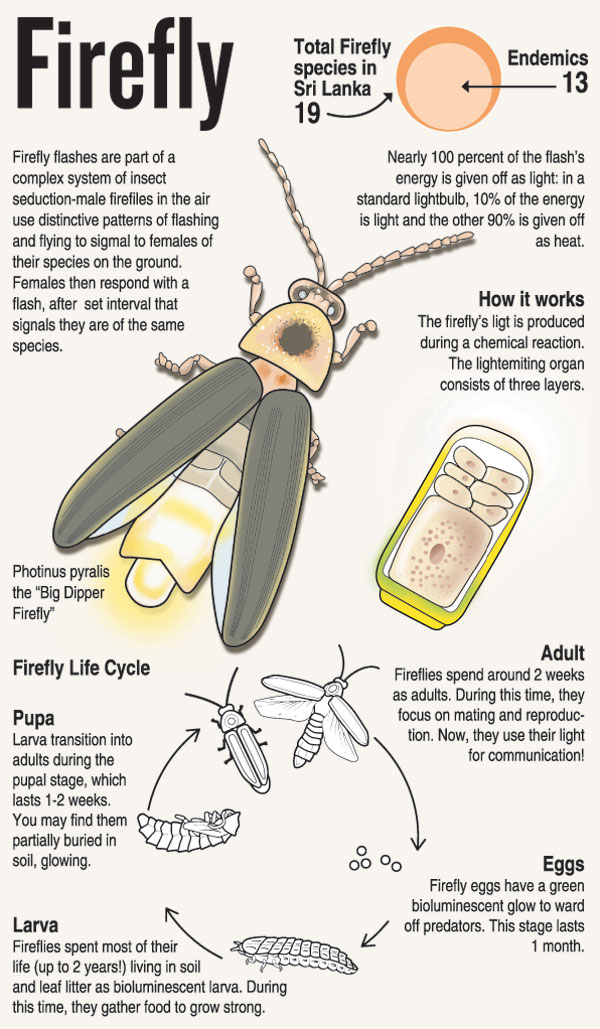News
Newly discovered fireflies stir hopes of other species
View(s):By Malaka Rodrigo
Fireflies are interesting insects as they produce a greenish light. While continuing their ongoing research on fireflies in Rammale Forest, a team of researchers from the University of Ruhuna noticed a few flying firefly species that looked different.
In addition to fireflies, there were wingless alien-looking glow worms [known in Sinhala as're badulla’] that emit light on their abdomen, in the leaf litter on the ground.
The team has also observed a firefly descending to mount a glow worm on the ground. The glowworm is, in fact, the female. So it was a mating that the team observed.

An odd looking mating pair – the male Diaphanes olivieri firefly mates with a glowworm which is the female of the same species
Further studies revealed that the species they observed is a firefly scientifically known as Diaphanes olivieri, which has not been recorded in Sri Lanka for the last 128 years.
“This is also the first time a female of this species was recorded from
Sri Lanka,” says Dr. Dammika Wijekoon, a scientist at the University of Ruhuna.
A lot of people think the glow worm is a different species altogether, but it would either be a larva or a female of a firefly species. While the female of the D. olivieri firefly species is in the glow worm form, many of the other firefly species, both male and female, are in the insect form, Dr. Wijekoon told the Sunday Times.
Fireflies are bioluminescent insects that can produce light. They have specialised light organs beneath their abdomens that produce light. These insects take in oxygen, and within specialised cells, the oxygen has a chemical reaction with a substance known as luciferin to generate light, emitting minimal heat in the process. The light pattern is unique to each species and is used to attract mates, Dr. Wijekoon said.
In addition to the firefly species discovered after a century, researchers at the University of Ruhuna also detected two species new to science.
One endemic species was named Pygoluciola ruhuna in honor of
the university.
All these species were discovered at Rammale Forest Reserve in Walasmulla, Hambantota.
The other endemic species was named Pygoluciola rammale to honour this biodiversity rich forest patch. These are the first records of fireflies from the genus Pygoluciola, according to the scientists.

There are 18 species of fireflies in Sri Lanka, but there is potential for more new species to be found. There are significant knowledge gaps due to insufficient research and information following the original species descriptions.
Fireflies grab attention due to their bioluminescent features, but after the colonial era, naturalists, very little research on them. Filling the void, the University of Ruhuna scientist Prof. Hemantha Wegiriya, together with Dr. Wijekoon, began new research in 2009. They discovered a number of new species
and rediscovered species unseen over a century.
Researchers usually go to the field around 5:30 p.m. to study these nocturnal creatures that emerge at twilight and continue working until around 10 p.m. They also carry insect-catching nets.
Folklore has it that if one is bitten by a glowworm, treatment will need mud from the oceans and stars from the sky. No treatment, in fact.
“Glowworms also have a neurotoxin venom similar to that of some snakes, but their mouths are very small, and the venom released is negligible,” says Dr. Wijekoon. Researchers on many occasions had been bitten, but nothing happened, so there is nothing to fear, he said.
Glowworms mostly feed on snails and slugs that are harmful to agriculture; hence, they are also friends of farmers, researchers say.
Fireflies used to be a common sight in village gardens at twilight. But while village gardens still have some surviving populations, people living in populated areas, especially children, may have never seen these flashing insects.
Dr.Wijekoon says factors ranging from pollution to habitat loss to changing climate could impact the fireflies, but light pollution, too, can be a factor in declining populations. “Excessive outdoor lighting disrupts the communication between fireflies, impacting their reproduction cycles,” he said.
The best way to say that you found the home of your dreams is by finding it on Hitad.lk. We have listings for apartments for sale or rent in Sri Lanka, no matter what locale you're looking for! Whether you live in Colombo, Galle, Kandy, Matara, Jaffna and more - we've got them all!

